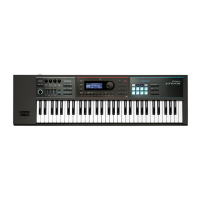57
MFX/Chorus/Reverb Parameters
Parameter Value Explanation
Delay Feedback # -98–+98[%]
Adjusts the proportion of the delay sound that
is fed back into the eect.
Negative (-) settings will invert the phase.
Delay HF Damp
200–8000[Hz],
BYPASS
Adjusts the frequency above which sound fed
back to the eect will be cut. If you do not want
to cut the high frequencies, set this parameter
to BYPASS.
Delay Balance # D100:0W–D0:100W
Adjusts the volume balance between the sound
that is sent through the delay (W) and the sound
that is not sent through the delay (D).
Level 0–127 Output level
76: FLANGER
0
DELAY
Feedback
Delay
L out
R out
Balance W
Balance W
Balance D
Balance D
Flanger
Balance W
Balance W
Balance D
Feedback
Parameter Value Explanation
Flanger Pre Delay 0.0–100[msec]
Adjusts the delay time from when the direct
sound begins until the anger sound is heard.
Flanger Rate # 0.05–10.00[Hz], note Frequency of modulation
Flanger Depth 0–127 Depth of modulation
Flanger Feedback # -98–+98[%]
Adjusts the proportion of the anger sound that
is fed back into the eect.
Negative (-) settings will invert the phase.
Flanger Balance # D100:0W–D0:100W
Volume balance between the direct sound (D)
and the anger sound (W)
Delay Time 0–2600[msec], note
Adjusts the delay time from the direct sound
until the delay sound is heard.
Delay Feedback # -98–+98[%]
Adjusts the proportion of the delay sound that is
fed back into the eect.
Negative (-) settings will invert the phase.
Delay HF Damp 200–8000[Hz], note
Adjusts the frequency above which sound fed
back to the eect will be cut. If you do not want
to cut the high frequencies, set this parameter to
BYPASS.
Delay Balance # D100:0W–D0:100W
Adjusts the volume balance between the sound
that is sent through the delay (W) and the sound
that is not sent through the delay (D).
Level 0–127 Output level
77: CHORUS
0
FLANGER
Feedback
Flanger
L in
R in
L out
R out
Balance W
Balance W
Balance D
Balance D
Chorus
Balance W
Balance W
Parameter Value Explanation
Chorus Pre Delay 0.0–100[msec]
Adjusts the delay time from the direct sound
until the chorus sound is heard.
Chorus Rate # 0.05–10.00[Hz], note Modulation frequency of the chorus eect
Chorus Depth 0–127 Modulation depth of the chorus eect
Chorus Balance # D100:0W–D0:100W
Volume balance between the direct sound (D)
and the chorus sound (W)
Flanger Pre Delay 0.0–100[msec]
Adjusts the delay time from when the direct
sound begins until the anger sound is heard.
Flanger Rate # 0.05–10.00[Hz], note Modulation frequency of the anger eect
Flanger Depth 0–127 Modulation depth of the anger eect
Flanger Feedback # -98–+98[%]
Adjusts the proportion of the anger sound that
is fed back into the eect.
Negative (-) settings will invert the phase.
Flanger Balance # D100:0W–D0:100W
Adjusts the volume balance between the sound
that is sent through the anger (W) and the
sound that is not sent through the anger (D).
Level 0–127 Output level
78: SYMPATHETIC RESO
On an acoustic piano, holding down the damper pedal allows other strings
to resonate in sympathy with the notes you play, creating rich and spacious
resonances. This eect simulates these sympathetic resonances.
R in
L out
Sym. Resonance
EQ
3-Band
Parameter Value Explanation
Depth # 0–127 Depth of the eect
Damper # 0–127
Depth to which the damper pedal is pressed
(controls the resonant sound)
Pre LPF
16–15000[Hz],
BYPASS
Frequency of the lter that cuts the high-
frequency content of the input sound (BYPASS: no
cut)
Pre HPF
BYPASS,
16–15000[Hz]
Frequency of the lter that cuts the low-frequency
content of the input sound (BYPASS: no cut)
Peaking Freq 200–8000[Hz]
Frequency of the lter that boosts/cuts a specic
frequency region of the input sound
Peaking Gain -15–+15[dB]
Amount of boost/cut produced by the lter at the
specied frequency region of the input sound
Peaking Q 0.5, 1.0, 2.0, 4.0, 8.0
Width of the frequency region boosted/cut by the
Peaking Gain parameter (larger values make the
region narrower)
HF Damp
16–15000[Hz],
BYPASS
Frequency at which the high-frequency content
of the resonant sound will be cut (BYPASS: no cut)
LF Damp
BYPASS,
16–15000[Hz]
Frequency at which the low-frequency content of
the resonant sound will be cut (BYPASS: no cut)
Lid 1–6
This simulates the actual changes in sound that
occur when the lid of a grand piano is set at
dierent heights.
EQ Low Freq 200, 400[Hz] Frequency of the low-range EQ
EQ Low Gain -15–+15[dB] Amount of low-range boost/cut
EQ Mid Freq 200–8000[Hz] Frequency of the midrange EQ
EQ Mid Gain -15–+15[dB] Amount of midrange boost/cut
EQ Mid Q 0.5, 1.0, 2.0, 4.0, 8.0
Width of midrange (larger values make the region
narrower)
EQ High Freq
2000, 4000,
8000[Hz]
Frequency of the high-range EQ
EQ High Gain -15–+15[dB] Amount of high-range boost/cut
Level 0–127 Output level
79: Di VOCODER
L in
MIC
L out
Mic Sens
Synth Level
Vocoder
Level
Parameter Value Explanation
Mic Sens # 0–127 Input sensitivity of the microphone
Synth Level # 0–127 Input level of the instrument
Mic Mix # 0–127
Amount of microphone audio added to the
output of the vocoder
Level 0–127 Volume level after passing through the vocoder
80: BIT CRUSHER
This creates a lo- sound.
L out
Bit Crusher
Bit Crusher
Parameter Value Explanation
Sample Rate # 0–127 Adjusts the sample rate.
Bit Down # 0–20 Adjusts the bit depth.
Filter # 0–127 Adjusts the lter depth.
Level 0–127 Output level
3
3
3
3
3

